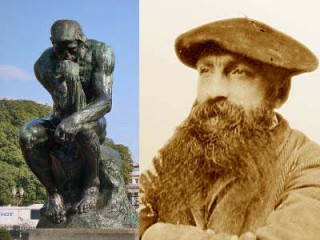
Auguste Rodin biography
Date of birth : 1840-11-12
Date of death : 1917-11-17
Birthplace : Paris, France
Nationality : French
Category : Arts and Entertainment
Last modified : 2010-04-28
Credited as : Sculptor of The Age of Bronze, The Thinker, The Gates of Hell
Although he was rejected three times into the Ecole des Beaux-Arts in Paris, Rodin would attain international fame and forever be considered by many as the Michelangelo of his time. He alone inspired a distinct style of sculpture and art that held true to the roots of western art – the perfection of the human figure.
Born to a police inspector in Paris, Rodin knew by the age of ten that he wanted to be an artist. He attended the School of Decorative Arts in Paris and studied literature and history simultaneously. He began a freelance practice of decorative and ornamental work. Upon the death of his sister, he decided to join a Christian group, but moved on to pursue his life in art, studying under Antoine Louis Barye.
Rodin then worked with Carrier-Belleuse for over five years and traveled together studying the art of Europe. The two then separated and Rodin began studying more his interest of the human figure under A. J. Rasbourg. It was in Italy, however, that Rodin’s imagination and true artistic genius surfaced. He saw the works of Donatello and Michelangelo and was inspired to create one of his most renowned masterpieces, the Age of Bronze. The piece caused uproar and was filled with controversy. It looked too real for anyone to believe. The piece was later purchased by the state.
Upon his return in 1883 to Paris, Rodin supervised a course in sculpture when he met the young 18-year old Camille Claudel. The two were described as “more than passionate” and were both the opposite’s muse. Claudel worked as Rodin’s model in a number of pieces, one of the most important named Thought. Rodin, however, wouldn’t fully commit to her and the two later separated.
He then began working on his rendition of St. John, which included his Walking Man. While working in bronze, he also began working in ceramics, where he released a number of sketches and engravings to the public. At this time, his fame was growing so much that the French government decided to commission him to design the doorway to the Museum of Decorative Arts, called the Gates of Hell. Considered Rodin’s most famous work that matched his previous endeavors was a statue originally called The Poet, but later titled The Thinker, commissioned by the Musée des Arts Décoratifs in Paris. It represented an age of intellect, reflection, imagination, and ironically, an age of satire.
Rodin also completed several commissions for private and government portraits. This included one of Victor Hugo, James Whistler, Napoleon, and even George Bernard Shaw. Many claim that Rodin’s work in sculpting was analogous to the movement of impressionism of the time -- space should be freeing and not limiting. However, others argue that his work is too rigid and exact to be considered impressionistic.
The Gates of Hell
A commission to create a portal for Paris' planned Museum of Decorative Arts was awarded to Rodin in 1880. Although the museum was never built, Rodin worked throughout his life on The Gates of Hell, a monumental sculptural group depicting scenes from Dante's Inferno in high relief. Often lacking a clear conception of his major works, Rodin compensated with hard work and a striving for perfection. He conceived The Gates with the surmoulage controversy still in mind: "…I had made the St. John to refute [the charges of casting from a model], but it only partially succeeded. To prove completely that I could model from life as well as other sculptors, I determined…to make the sculpture on the door of figures smaller than life." Laws of composition gave way to the Gates' disordered and untamed depiction of Hell. The figures and groups in this, Rodin's meditation on the condition of man, are physically and morally isolated in their torment.
The Gates of Hell comprised 186 figures in its final form. Many of Rodin's best-known sculptures started as designs of figures for this composition, such as The Thinker, The Three Shades, and The Kiss, and were only later presented as separate and independent works. Other well-known works derived from The Gates are Ugolino, Fugit Amor, The Falling Man, and The Prodigal Son.
The Thinker (originally titled The Poet, after Dante) was to become one of the most well-known sculptures in the world. The original was a 27.5-inch (700 mm)-high bronze piece created between 1879 and 1889, designed for the Gates' lintel, from which the figure would gaze down upon Hell. While The Thinker most obviously characterizes Dante, aspects of the Biblical Adam, the mythological Prometheus, and Rodin himself have been ascribed to him. Other observers de-emphasize the apparent intellectual theme of The Thinker, stressing the figure's rough physicality and the emotional tension emanating from it.
Other works
The Age of Bronze (L'age d'airain), 1877
The Walking Man (L'homme qui marche), 1877-78
The Burghers of Calais (Les Bourgeois de Calais), 1889
The Kiss, 1889
The Thinker (Le Penseur), 1902
















